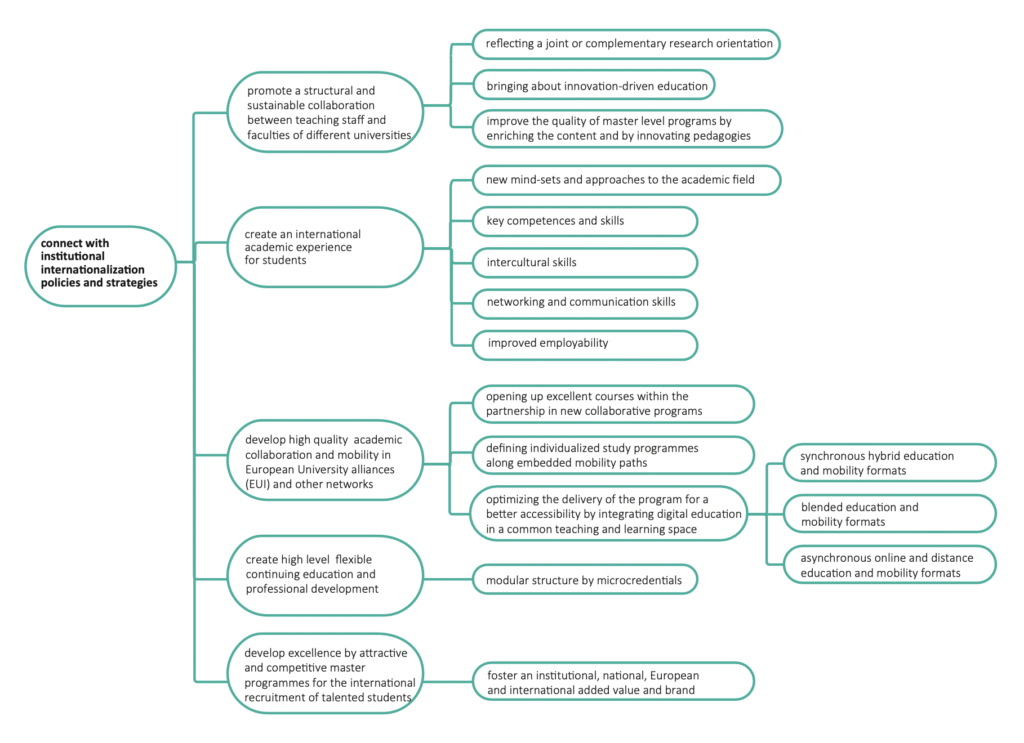
| Joint master’s programmes engage universities as an institution and should connect writ institutional policies strategies and frameworks for internationalization |
| • promote a structural and sustainable collaboration between teaching staff and faculties of different universities; |
| • create an international academic experience for students; |
| • develop high quality academic collaboration and mobility in EUI alliances and networks; |
| • create high level flexible continuing education and professional development; |
| • develop excellence by attractive and competitive programmes for talented international students. |
Guidelines
Promote a structural and sustainable collaboration between teaching staff and faculties from different universities
Universities promote academic collaboration between teachers and faculties from different universities. Joint master’s programmes reflect this policy, as teaching staff and faculties initiate curriculum collaboration or accept the invitation of peers from other universities to join a programme with them. In most cases, this collaboration is based on a joint or complementary research orientation or on previous educational collaboration and/or mo- bility (e.g. Erasmus mobility).
This collaboration leads to the creation of an innovation-driven joint master’s degree that prepares students for a strong contribution to the economy and society.
Through this common and complementary nexus in research and innovation, the partner universities improve the quality of the master’s programme offered by enriching the con- tent and innovating pedagogical methods to make the programme accessible to students in the partnership and beyond.
Joint master’s programmes should base their curriculum on this common and comple- mentary link between research, innovation and education.
Create an international academic experience for students
Universities want to create an international academic experience for their students. In joint master’s programmes, this experience is structurally embedded in the curriculum through successive mobility periods.
Throughout the programme, students study in a cohort of international students taught by international staff in a common learning space created by partner universities. They learn new ways of thinking and strengthen their core knowledge and skills in their academic field.
This international experience gives students the opportunity to develop intercultural, networking and communication skills in physical and digital environments.
This leads to better (international) employability of students.
Joint master’s programmes should consciously integrate these institutional mobility ob- jectives into the curriculum to provide a strong international academic experience.
Develop high-quality academic collaboration and mobility in alliances of European universities (EUI) and other networks
Many universities are members of European University Initiative alliances (EUI) and other networks that take initiatives for joint programmes at all levels (bachelors, master’s, doc- torate, microcredentials).
Alliances and networks or structured collaborations between universities that share a common mission and a similar academic culture. They develop collaborative programmes that open up excellent courses to the entire partnership and enrich the content of the com- mon educational offer. Individualized curricula for their students along with embedded mobility paths are integrated into the programme.
To make the programme and mobility pathways accessible, affordable and more effective for all students, university alliances and networks are integrating digital education and mobility formats into the collaborative programmes. Current approaches mainly include synchronous hybrid (e.g. virtual classrooms, webinars, lecture series) (Raes, 2020), syn- chronous and asynchronous blended (Goeman et al., 2019; van Valkenburg et al., 2020) and asynchronous online forms of distance education and mobility.
Joint programmes should develop innovative forms of education and mobility that can be integrated into a common teaching and learning space for all staff and students involved in the programme.
Create flexible continuing education and high-level professional development
Universities are increasingly developing policies and creating extension schools for con- tinuing education and professional development, using digital education formats to scale and make their offerings more flexible, especially for students who combine work and study.
The European Institute of Innovation and Technology supports digital master’s schools in the Knowledge Innovation Communities (KICs) in all areas such as energy, climate, health, urban mobility, raw materials, manufacturing and food. This demonstrates the need for cooperation in continuing education and professional development.
Joint master’s programmes for these target groups can be built modularly on the basis of microcredentials and microdegrees in line with the proposal for EC Recommendation to the Council of Ministers on Microcredentials (European Commission, 2021). This will encourage students to take smaller programmes that respect their work-life balance and push them to continue their studies to a master’s degree.
Connect with institutional policies and strategies
Models and guidelines for joint master’s programmes
Scalable and flexible continuing education and professional development solutions are needed to meet the needs for innovation and entrepreneurship in priority sectors of the economy.
Develop excellence through attractive and competitive master’s programmes for the international recruitment of talented students
A large number of European universities participate in the Erasmus Mundus programme that develops joint master’s (EMJM) to recruit talented international students for further study at their institutions. The European Commission provides scholarships to attract stu- dents to selected programmes (European Commission ,2021).
In Erasmus Mundus programmes, physical mobility is mandatory for following the indivi- dual learning paths. Innovative digital teaching methods are applied, for example to make the study more effective through blended learning or to bring dispersed groups of students together in the partnership through virtual classrooms and webinars or through joint projects online.
Erasmus Mundus programmes provide institutional, national, European and international added value. Collaboration between existing master’s programmes in the relevant disciplines can deliver on this promise and organize a competitive offer.
These programmes are labeled with Erasmus Mundus, profiling them worldwide.
Interested consortia can apply for a preparation grant to design an Erasmus Mundus joint master’s.
next chapter: Create the partnership for the joint master’s programme
previous chapter: The design of a joint master’s programme: overview
back to overview: Models and guidelines for the design and development of joint master’s programmes
